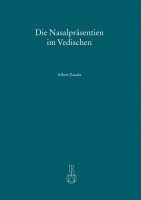Search
Die Nasalpräsentien im Vedischen
Short Description
This book constitutes a comprehensive study of the Vedic nasal presents from a synchronic and diachronic perspective. Each present in question is discussed in the frame of a individual lemma which contains an analysis of its uses, of the structure of its paradigm and, where necessary, of its form. The results of these detailed analyses are then summarized in a survey of the formal and functional characteristics of the class. The main focus lies on the valency of the nasal presents, since they can serve both as causatives and as non-causativizing present formations. The results of these detailed analyses are then summarized in a survey of the formal and functional characteristics of the class.Description
This book constitutes a comprehensive study of the Vedic nasal presents from a synchronic and diachronic perspective. Each present in question is discussed in the frame of a individual lemma which contains an analysis of its uses, of the structure of its paradigm and, where necessary, of its form. The results of these detailed analyses are then summarized in a survey of the formal and functional characteristics of the class. The book adds to the existing series of monographs on other Vedic verbal formations and thus provides a further building block to our overall understanding of synchronic Vedic grammar and of the history of the Indo-European verbal system.The study of the formal features concentrates on how the different manifestations of the nasal presents – infixed presents, nā-presents, āya-presents, nu-presents – correlate with different root structures. Although Indo-Europeanists have been interested in the form of the nasal presents from the very early stages of the field, the systematic study of the Vedic data furnishes important new insights that are particularly relevant for the reconstruction of the nu-presents of Proto-Indo-European.
The main focus of the book, however, lies on the function and paradigmatic role of the nasal presents, a problem that has hitherto been studied rather scarcely. It has long been known that nasal formations are productive in causative function in the Anatolian languages, whereas they normally serve as mere present stems in other old Indo-European languages. In order to explain this dichotomy, Vedic plays a crucial role in that it displays several causative nasal presents alongside its numerous non-causative ones, hence taking a middle position in this respect. The present study, in which, therefore, valency is given particular weight, clarifies the synchronic formal and semantic differences between paradigms with causative and with non-causative nasal presents. From these findings, conclusions are drawn about Proto-Indo-European, which indeed are able to reconcile the Anatolian facts with the other Indo-European languages.




 Preface
Preface

 Neuerscheinungen 2023/2024
Neuerscheinungen 2023/2024
 Gesamtverzeichnis 2023/2024
Gesamtverzeichnis 2023/2024
 Katalog Oriental Studies & Linguistics
Katalog Oriental Studies & Linguistics
 Mittelalter
Mittelalter
 Deutsche Inschriften
Deutsche Inschriften
 Musiktherapie
Musiktherapie
 Literaturen im Kontext
Literaturen im Kontext